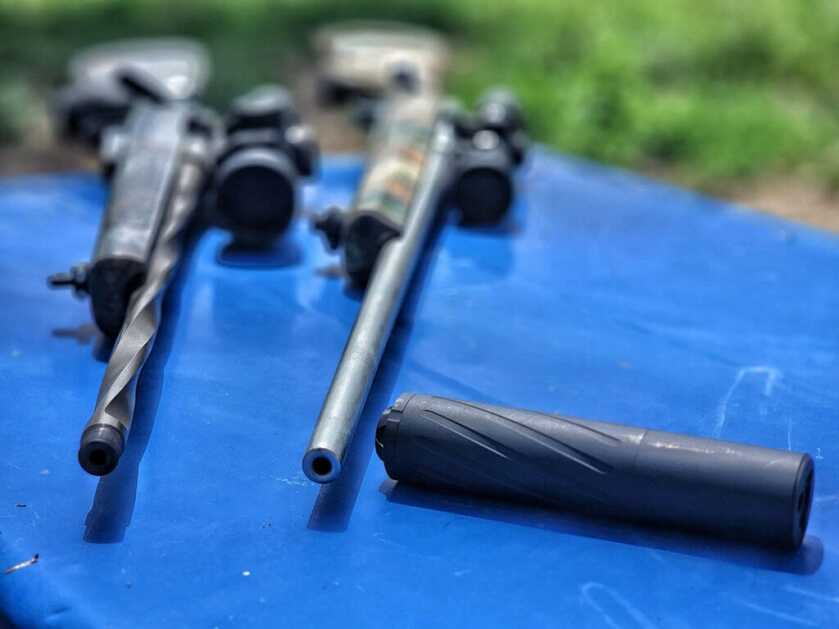

You’ve paid for your suppressor, submitted all your paperwork and tax to the ATF and now you’re waiting. What should you be doing to ensure that you can put rounds downrange the moment your suppressor arrives?
Depending on the firearms you own you may need to make some modifications, purchase some adapters, or buy some new guns to attach to your suppressor.
Suppressors are attached to your firearm in one of two ways: 1) they thread directly to the muzzle of your gun or 2) you attach a muzzle device like a brake or flash hider to your barrel that is specifically designed to attach to your suppressor. The second method is called QD, stands for Quick Detach, and is usually slightly faster at attaching the suppressor to your gun than threading your suppressor on and off the barrel. We’ll cover QD attachments more in an upcoming article. Either way though, you need to have your barrel threaded.
For most applications, I prefer option 1, direct thread. I don’t like excess weight out on the end of the barrel and attaching your barrel by direct threading is lighter, simpler, and usually less expensive.
The best way to have your barrel threaded is to buy one already threaded from the factory. Many hunting rifles, most AR-style rifles, and almost all modern precision-style bolt actions come with the muzzle threaded. If you are dealing with a semi auto handgun, many manufacturers now offer tactical models that come with a threaded barrel or you can purchase a drop-in aftermarket barrel for your pistol.
Suppressors Delivered to Your Door
One call, does it all. Select your suppressor, create your trust, fit your gun, deliver to your doorstep. Silencer Central – Simple, Smart, Easy! Call 866-693-3982 or visit https://www.silencercentral.com/about-us/
The second best way is to have your rifle muzzle threaded. It’s important that this be done by someone competent so that the threads are in line with the bore. This usually requires a lathe to do properly. If the barrel is threaded and not in line with your bore then you can have a bullet potentially hit the inside of your suppressor. This is often referred to as a baffle strike and it can cause major damage to your suppressor.
If you’ve got a barrel that needs to be threaded you can hit up your local gunsmith. Many charge $150 or more to thread a rifle barrel. Silencer Central offers a service where you mail them your gun and they thread it for $99 on a CNC lathe and ship it back to you. I haven’t personally tried the service but it’s certainly an option and should work for you regardless of what state you live in. You can learn more about it here.
Your suppressor will most likely come threaded in one of several common thread sizes and you need to ensure that you have a barrel threaded to match the threads of your suppressor.
Most Common Rifle Suppressor Thread Sizes
½-28 is the most common thread size for .22 caliber suppressors. So, any caliber that is .223/556 would fit ½-28 threads, including 22 rimfires. It’s also the most common size for muzzle brakes and flash suppressors designed for 22 calibers. The standard muzzle thread size for AR-15s in 223/556 is ½-28.
⅝-24 is the most common thread size in suppressors for calibers larger than .223 and up to .30 caliber. For example, .243/6mm, .264/6.5, .270/6.8, .284/7mm, .and 308/7.62 would all generally use a ⅝-24 thread size. ⅝-24 is also the most common muzzle brake thread size for 30 caliber barrels. AR-15s chambered in 300 Blackout would use a ⅝-24 thread size as would almost all AR-10s.

Attaching a Suppressor to a Pistol

Most semi-auto 9mm pistols are threaded ½-28, but there are certainly some exceptions to that so you should check and do your homework so that you have exactly what you need.

The purpose here isn’t to list every single possible thread size. Most pistol suppressors have thread adapters for weird threads available from the suppressor manufacturer.
I regularly use a 30 caliber suppressor with a ⅝-24 thread on .223 caliber rifles that are threaded ½-28 by using a cheap thread adapter that can be purchased from Brownells, Midway, or even eBay. Search for Thread Adapter ½-28 to ⅝-24. I’ve bought these for as little as $10.

Some hunting rifles with sporter profile barrels don’t have enough metal to thread ⅝-24. As a general rule, your barrel should measure larger than 0.675 in order to safely thread ⅝-24. If your barrel is under 0.675 I recommend having your barrel threaded 9/16-24 by a competent gunsmith and buying a thread adapter 9/16-24 to ⅝-24 from Brownells. You then red Loctite the thread adapter on and are good to go.
After all the waiting for your suppressor to get out of jail, the last thing you want to happen is to have it not fit your firearm or have the adapter you need out of stock. Now is the time to make sure your firearms will be compatible with your suppressor by getting your barrels threaded or by buying adapters.
Interested in getting a suppressor? Check out GunsAmerica’s Suppressor Academy.

